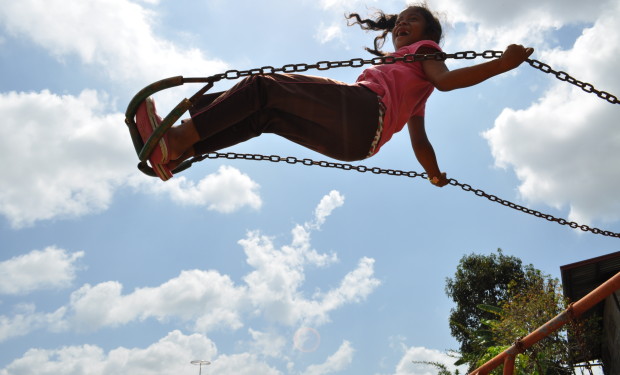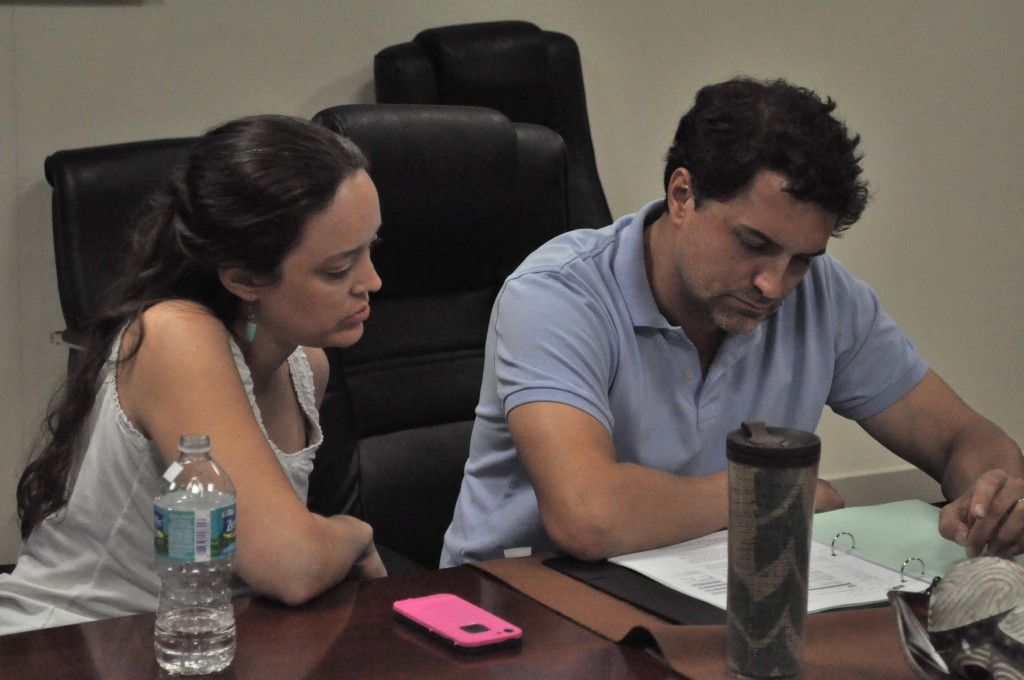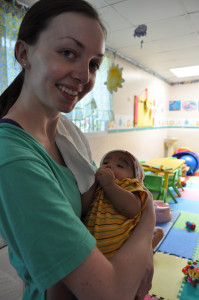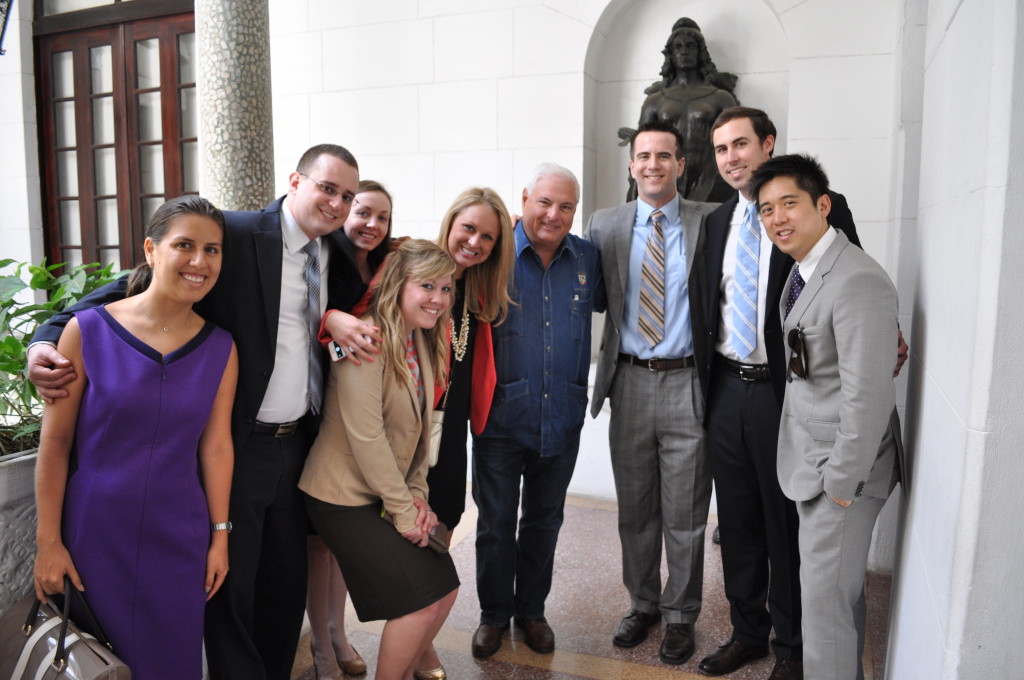A souvenir from Panama
Students get a new perspective—practicing law is not about what you want to do for a living, but who you feel called to serve.
It was Ash Wednesday in Panama and the chilling sound of children singing rang out from the open-air cathedral at the Malambo orphanage. Colorful pictures of animals and smiling children were painted on the concrete walls. Young children—too young to attend the church service—played quietly with stuffed animals and toy cars behind iron gates.
One nine-year-old boy, who should have been attending the service, had snuck out to greet us with a hug as our group approached a living quarter near the end of the courtyard. Edwin grabbed my hand and pressed it against his forehead.
I was there on spring break with a group of five other law students from Campbell Law School and Professor Lucas Osborn. We had spent the first half of the spring semester studying international adoption law, Panamanian history, and the civil code. We had also conducted legal research to help Heart’s Cry Children’s Ministry, a North Carolina non-profit founded by Campbell Law alumnus Misty Hedspeth and her husband Matt, with the development of an orphanage for children with special needs. We had travelled there to present our research to them and to get a first-hand perspective on international law.
My Spanish skills were a little rusty, but I remembered enough from high school Spanish to know that Edwin wanted to play soccer. Two classmates and I grabbed a deflated ball on the playground and took turns kicking the ball into a wall that he designated as a goal. Rex Cho, a third-year student, pulled out his camera and asked me to take photographs of the children. Edwin soon took hold of the camera himself and scrolled through his photographs. Pictures of New York City, subway stations, and animals in a zoo abounded from the camera.
“The city?” he asked. “The metro?”
It struck me at that moment that Edwin has probably only experienced the outside world in books and pictures. He had lived at the Malambo orphanage institution for as long as he could remember, and the pictures were foreign to his reality. The institution was the only life he knew, and at the age of nine, it is unlikely that he will be placed in a permanent family home.
“Edwin is adoptable,” explained one of the nuns in charge of caring for the children. “But he is too old.”
So it is for orphans like Edwin who surpass infancy and grow up in institutions. Yes, the children have food, water, and shelter. But they lack permanent caregivers—someone to hold them, someone to teach them appropriate emotional responses and reactions to social cues. Some of the children living in institutions, if not most, experience sexual abuse from other children at a very young age. As a result, children who spend years living in institutions have stunted emotional, physical, and psychological development. They call it institutionalization (pdf).
All institutionalized children fall behind in motor development, speech acquisition and necessary social skills.
Institutionalization is marked by the child’s inability to develop due to lack of permanency. Children that are institutionalized exhibit behavioral abnormalities, such as delays in social and emotional development. Physical growth is also delayed. Studies have shown that children living outside of family care lose one month of growth for every three months while living in an institution. Furthermore, children living in institutions have a deficit IQ, diminished brain activity, and a deficiency in sensory response, including responses to facial emotion.
“The science is there, but it is going to take social change for people to acknowledge that this is an issue,” said Misty about the culture regarding orphans in Panama. “People think that because the children have a place to eat, somewhere to sleep, and someone taking care of them then they are fine.”
While the effects of institutionalization on a child’s psyche may vary, there is a growing consensus that the sooner a child is placed in permanent parental care the better. In a permanent home, children are less likely to experience the developmental problems associated with institutionalization. For example, children that are placed with a permanent family before two years old exhibit a significant improvement in cognitive functioning, whereas those entering a family home after that age improve much less.
The effects of institutionalization are enduring and can haunt a child throughout his or her life.
Permanent family home placement is the best scenario for children in institutions.
Misty and Matt are hoping to quell the effects of institutionalization at Casa Provedencia, the orphanage they are currently developing. The building that will house the institution is an old bed and breakfast located in a neighborhood that was once home to United States military. Matt gave our group a tour of the facility, painting a picture of all they hope it will one day be.
“We are trying to make it as close to a permanent home as possible,” Matt said, explaining that many children with special needs who enter institutions are likely to stay until they reach the age of adulthood. The institution may be the closest thing to home the children will ever know.
It is an inspiring vision, and one that will hopefully influence change in children’s care in institutions in Panama and abroad. Yet, the best possible scenario for the children remains permanent family home placement.
Getting children out of institutions and into permanent homes is the challenge. This is due in part to the obstacles that adoption laws can present (pdf), especially in the international context where adoption laws lack uniformity. Some countries’ adoption systems are heavily regulated, creating sluggish bureaucratic systems. On the end of the spectrum, there are other countries where adoption regulation borders on corruption.
The Hague Convention provides safeguards and a system of cooperation between contracting states in international adoption.
There are very few countries that have created laws to facilitate adoptions by parents in foreign countries; and some countries prohibit all international adoptions. If international adoption is allowed, the law of the sending country is applied to decide which children are eligible for adoptive placement. The sending country also determines whether the adoptive parents must travel to the country to complete the adoption, or if the child can be sent abroad for the adoption. In turn, adoption processes that may work well for domestic adoptions can be overwhelmingly burdensome for the adoptive parents of a foreign nation.
The Hague Convention on Protection of Children and Co-Operation in respect of Intercountry Adoption was first created in 1993 to establish safeguards and a system of cooperation (pdf) between contracting countries to ensure that international adoptions take place in the best interest of the children. The Convention was aimed at preventing the abduction, selling, and trafficking of children in response to the valid fear that children were being taken or bought by agencies in impoverished countries to be sold abroad.
The Convention states that domestic adoptions are most favorable, but it also recognizes the advantages of permanent home placement regardless of borders. Countries adhering to the Convention must establish a central authority to be the authoritative source of information and point of contact. Also, international adoptions can take place only when a suitable family has not been located in the child’s country of origin, and the child’s country of origin deems the child to be eligible for adoption.
Additional requirements under the Convention mandate that all service providers be accredited by an accrediting entity that evaluates standards to guarantee ethical practices. Furthermore, accredited adoption agencies must provide full disclosure on expenses, including money paid to the staff of the agency in connection to the adoption.
While many have applauded the Convention for creating uniform supervision of international adoptions, many have criticized the Convention’s provisions. The creation and staffing of a Central Authority, for example, is economically feasible in developed countries like the United States. However, developing countries (which have the greatest need for international adoption) might not have the requisite resources to create a Central Authority in conformity with the Convention’s requirements.
The laws of the country of birth decide whether a child is adoptable, which can postpone the adoption process.
After we ate lunch at Malambo, our group went to the medical unit of the orphanage, where children with HIV were treated. One little girl, maybe five-years-old, gave me a tour of her “home.” She showed me her bedroom, a picture she colored, and a photograph of her at the beach.
“This is me and that is my mom,” she explained. For a moment I was confused. The photo was not taken long ago, and the little girl talked about spending time with her family, yet she was in Malambo.
What I later learned from Misty offered an explanation. In Panama, as is the case in other foreign countries, a child is not deemed adoptable as long as the biological parents make regular visits. In some cases parents visit weekly, but in other cases the parents come just enough to prevent the forfeiture of parental rights.
Even in cases where it is determined that a child has been abandoned by his or her biological parents, the state must seek to place the child with a blood relative before allowing an adoption to take place. Great lengths are taken to reach distant relatives, sometimes travelling hundreds of miles is required.
“The children are taken to each of their relatives, many that they have never met,” Misty explained. “And these kids face rejection after rejection from their own family members.”
Excursions to find blood relatives do not happen quickly, either. Months, even years, can pass before every blood relative is contacted. In the meantime, the child waits in an institution.
To help the children, adoption policies will have to change.
At the end of our trip, we sat in a café overlooking the bay in Casco Viejo. For a moment, I reflected on all I had seen and the work we had done. I thought about Misty and Matt and how they threw a Hail Mary to pursue a life of service. Never have I felt called to work with children—and the trip did not change that—but I was reminded that the legal profession is a calling to serve others.
International adoption laws are in serious need of reform, and lawyers have the power to make the changes it needs. Our trip to Panama gave us a new perspective. Though we may not have a desire to practice in the area of adoption law, there are many other problems, both foreign and local, that only lawyers have the ability to fix. So instead of thinking about what I want to do, my goal is to imagine the kind of client that I feel called to serve. The law is a powerful tool to affect change, and I plan to do just that.









